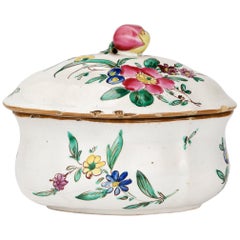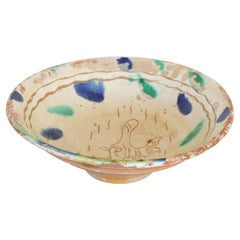Antonio Ferretti Decorative Bowls
to
1
1
1
1
1
1
1
1
1
Height
to
Width
to
1
1
1
8
145
139
110
87
Creator: Antonio Ferretti
Italian Maiolica Ancient Sugar Bowl, Lodi, 1770-1780
By Antonio Ferretti
Located in Milano, IT
Maiolica sugar bowl
Antonio Ferretti Manufacture
Lodi, Circa 1770-1780
Maiolica polychrome decorated “a piccolo fuoco” (third fire).
It measures 3.54 x 4.52 x 3.54 in (9 x 11,5 x 9 cm)
Weight: 0.394 lb (0.179 kg)
State of conservation: small and slight chips on the edges.
The small sugar bowl has a swollen and ribbed body resting on a flat base. The cap-shaped lid follows the rib of the container and is topped with a small knob in the shape of a two-colored fruit.
The sugar bowl is painted “a piccolo fuoco” (third fire) with the characteristic floral motif of bunches and isolated semis.
An example which closely corresponds to this one is kept at the Civic Museum in Lodi (G. Gregorietti, Maioliche di Lodi, Milano e Pavia, Catalogo della Mostra, Milano, 1964 n. 137).
This decorative style represented a strong point of the Lodi factory, which established itself thanks to the vivid nature of the colors made possible by the introduction of a new technique perfected by Paul Hannong in Strasbourg and later introduced by Antonio Ferretti to Italy. The production process, called “piccolo fuoco” (third fire), allowed the use of a greater number of colors than in the past; in particular, the purple of Cassius, a red made from gold chloride, was introduced. Its use allowed for many more tones and shades, from pink to purple.
The Ferretti family started their maiolica manufacturing business in Lodi in 1725.
The forefather Simpliciano started the business by purchasing an ancient furnace in 1725 and, indeed, we have evidence of the full activity of the furnaces starting from April of the same year (Novasconi-Ferrari-Corvi, 1964, p. 26 n. 4). Simpliciano started a production of excellence also thanks to the ownership of clay quarries in Stradella, not far from Pavia. The production was so successful that in 1726 a decree of the Turin Chamber came to prohibit the importation of foreign ceramics, especially from Lodi, to protect internal production (G. Lise, La ceramica a Lodi, Lodi 1981, p. 59).
In its initial stages, the manufacture produced maolicas painted with the “a gran fuoco” (double fire) technique, often in turquoise monochrome, with ornamentation derived from compositional modules in vogue in Rouen in France. This was also thanks to the collaboration of painters like Giorgio Giacinto Rossetti, who placed his name on the best specimens next to the initials of the factory.
In 1748 Simpliciano made his will (Gelmini, 1995, p. 30) appointing his son Giuseppe Antonio (known as Antonio) as universal heir. After 1750, when Simpliciano passed away, Antonio was directly involved in the maiolica factory, increasing its fortunes and achieving a reputation on a European level. Particularly important was the aforementioned introduction in 1760 of the innovative “a piccolo fuoco” (third fire) processing, which, expanding the ornamental repertoire with Saxon-inspired floral themes, was able to commercially compete with the German porcelains that had one of its most renowned offerings in the naturalistic Deutsche Blumen. Antonio Ferretti understood and promoted this technique and this decoration, proposing it in a fresher and more corrective version, less linked to botanical tables, both with or without contour lines, as well as in purple or green monochrome. After efforts to introduce more industrial production techniques to the sector succeeded, even the Ferretti manufacture, in the last decade of the eighteenth century, started heading towards decline despite its attempts to adapt production to neoclassical tastes.
In 1796 the Napoleonic battle for the conquest of the Lodi bridge over the Adda definitively compromised the furnaces. Production resumed, albeit in a rather stunted manner, until Antonio's death on 29 December 1810. (M. L. Gelmini, pp. 28-30, 38, 43 sgg., 130-136 (for Simpliciano); pp. 31 sgg., 45-47, 142-192 (for Antonio).
Bibliography
G. Gregorietti, Maioliche di Lodi Milano e Pavia Catalogo della Mostra, Milano, 1964 n. 137;
C. Baroni, Storia delle ceramiche nel Lodigiano, in Archivio storico per la città e i comuni del circondario e della diocesi di Lodi, XXXIV (1915), pp. 118, 124, 142; XXXV (1916), pp. 5-8;
C. Baroni, La maiolica antica di Lodi, in Archivio storico lombardo, LVIII (1931), pp. 453-455;
L. Ciboldi, La maiolica lodigiana, in Archivio storico lodigiano, LXXX (1953), pp. 25 sgg.;
S. Levy, Maioliche settecentesche lombarde e venete, Milano 1962, pp. 17 sgg.;
A. Novasconi - S. Ferrari - S. Corvi, La ceramica lodigiana, Lodi 1964, ad Indicem; Maioliche di Lodi, Milano e Pavia (catal.), Milano 1964, p. 17;
O. Ferrari - G. Scavizzi, Maioliche italiane del Seicento e del Settecento, Milano 1965, pp. 26 sgg.;
G. C. Sciolla, Lodi. Museo civico, Bologna 1977, pp. 69-85 passim; G. Lise, La ceramica a Lodi, Lodi 1981;
M. Vitali, in Storia dell'arte ceramica...
Category
1770s Italian Rococo Antique Antonio Ferretti Decorative Bowls
Materials
Maiolica
Related Items
Guido Gambone Stoneware Bowl Donkey Mark Signature, Italy, 1950s
By Guido Gambone
Located in Munich, DE
Huge ceramic bowl by Guido Gambone with brown and orange glaze.
Signed on the bottom with the donkey mark.
Guido Gambone (1909 – 1969) is one of ...
Category
1950s Italian Mid-Century Modern Vintage Antonio Ferretti Decorative Bowls
Materials
Stoneware
Spanish Painted Terracotta Bowl
Located in Los Angeles, CA
Stunning terracotta bowl from Spain, 1960's. Beautiful blue and green painted detail with etched fish design and etched wavy edge detailing. Great vintage condition. Can be hung on a...
Category
Mid-20th Century French Antonio Ferretti Decorative Bowls
Materials
Ceramic
Petite French Ceramic Bowl
Located in Los Angeles, CA
Beautiful petite ceramic bowl from France, 1950s. Circular dish with small handles and painted in a creamy white. Glazed surface shows nice age with small chip and patina. Perfect as...
Category
Mid-20th Century French Antonio Ferretti Decorative Bowls
Materials
Ceramic
Petite French Painted Bowl
Located in Los Angeles, CA
Beautiful painted petite ceramic bowl from France, 1950s. White circular dish with blue painted flower motif. Signed on the underside. Perfect as a catch-all or decorative piece.
Category
Mid-20th Century French Antonio Ferretti Decorative Bowls
Materials
Ceramic
Petite French Painted Bowl
Located in Los Angeles, CA
Beautiful painted petite ceramic bowl from France, 1950s. White circular bowl with blue painted flower motif. Signed on the underside. Perfect as a catch-all or decorative piece.
Category
Mid-20th Century French Antonio Ferretti Decorative Bowls
Materials
Ceramic
Fratelli Fanciullacci Fruit Bowl
By Fratelli Fanciullacci
Located in Waddinxveen, ZH
Fratelli Fanciullacci Pottery: during the first half of the 20th century the firm slowly branched out into a rich repertoire of artistic products. The family understood the pulse of ...
Category
1960s Italian Mid-Century Modern Vintage Antonio Ferretti Decorative Bowls
Materials
Ceramic
18th Century Italian Majolica Faience Centerpiece Large Lodi Circular Bowl
Located in Milano, MI
18th century Italian collectible antique painted majolica bowl, a large basin-shaped centerpiece, with vertical ribs, decorated with polychrome flowers. Small chips, felure and minor...
Category
Mid-18th Century Italian Rococo Antique Antonio Ferretti Decorative Bowls
Materials
Maiolica
$1,806
H 5.12 in Dm 11.82 in
Large Antique Italian Faience Centrepiece Bowl
Located in Hamilton, Ontario
This very large and very colorful Italian Majolica centrepiece bowl was made between 1900 and 1920 in the Renaissance Revival style. The sides show hand painted blue peacocks surroun...
Category
Early 20th Century Italian Renaissance Revival Antonio Ferretti Decorative Bowls
Materials
Majolica
Mid-Century Fratelli Fanciullacci Italy Bowl
By Fratelli Fanciullacci
Located in Waddinxveen, ZH
Stunning and vibrant bowl with sgrafitto and hand-painted colored glossy pattern of stylised women. On the base is painted Italy 7892.
Fratelli Fanciullacci Pottery: during the fi...
Category
Mid-20th Century Italian Mid-Century Modern Antonio Ferretti Decorative Bowls
Materials
Ceramic
Italian Ceramic Horse Bowl
Located in New York, NY
Masterfully created whimsical horse bowl in the manner of 1960s Italian ceramics like Gambone with a gold and terracotta design. Signed.
Category
1960s Italian Vintage Antonio Ferretti Decorative Bowls
Materials
Terracotta
Antique Continental Maiolica Moulded Lustre Figural Wall Plaque / Dish
Located in Bishop's Stortford, Hertfordshire
A superb antique relief moulded Continental Maiolica dish or plaque relief moulded with a side profile portrait of a figure wearing a military helmet and with the words DUX D'URBINUS...
Category
19th Century European Antique Antonio Ferretti Decorative Bowls
Materials
Earthenware, Maiolica
Mid Century Lidded Bowl by Ceramiche Batignani, Italy
By Ceramiche Batignani
Located in Albano Laziale, Rome/Lazio
A beautiful pumpkin shaped bowl with lid crowned by a brass handle by Ceramiche Batignani from the 1950's. This handmade bowl is in perfect condition.
Category
Mid-20th Century Italian Mid-Century Modern Antonio Ferretti Decorative Bowls
Materials
Ceramic
Antonio Ferretti decorative bowls for sale on 1stDibs.
Antonio Ferretti decorative bowls are available for sale on 1stDibs. These distinctive items are frequently made of maiolica and are designed with extraordinary care. There are many options to choose from in our collection of Antonio Ferretti decorative bowls, although beige editions of this piece are particularly popular. Many of the original decorative bowls by Antonio Ferretti were created in the Rococo style in italy during the 18th century and earlier. Prices for Antonio Ferretti decorative bowls can differ depending upon size, time period and other attributes — on 1stDibs, these items begin at $1,602 and can go as high as $1,602, while a piece like these, on average, fetch $1,602.


